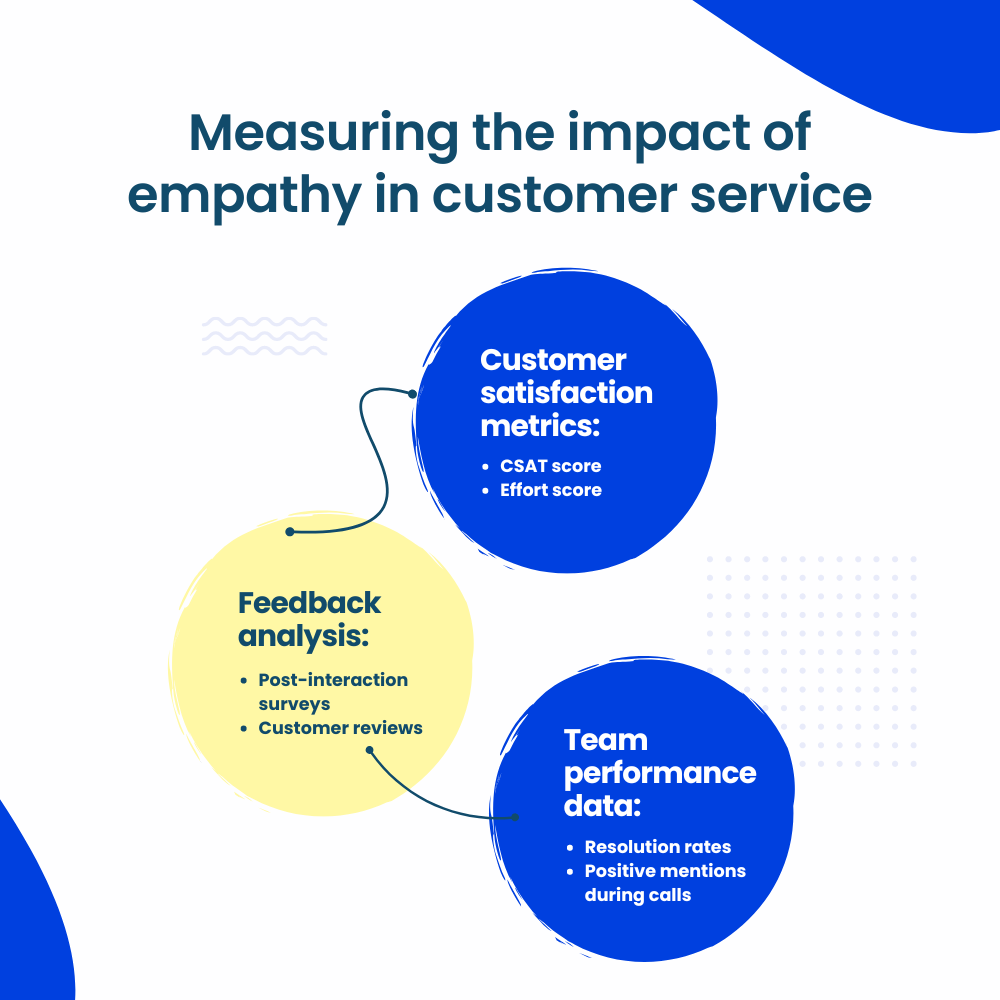52% of consumers have stopped buying from a company due to poor communication, with 17% citing “insensitivity” as the primary reason.
This gives a strong enough reason to ask your customer service agents empathize with customers while resolving their concerns.
In this article, we’ll discuss the tactics to help your support reps show empathy to customers.
7 Ways to Show Empathy to Customers
While resolving issues efficiently is crucial, showing genuine concern creates a positive customer experience that builds loyalty and trust.
Here’s how you can train your team to prioritize empathy in customer service.

1. Actively listen
Empathy starts with truly understanding the customer’s situation.
Active listening is the key here.
It entails focusing solely on the customer, avoiding interruptions, and summarizing key points to confirm understanding.
Here’s an example of how to put this principle in practice.
A customer calls frustrated because their new software isn’t working as expected. Actively listening involves acknowledging their frustration (“I understand this must be very frustrating for you“) and summarizing the issue (“So, you’re unable to access the key feature you need“).
2. Use statements that show empathy
Train your team to use empathy statements throughout the interaction. These phrases acknowledge the customer’s emotions and validate their experience.
For example,
“It sounds like you’ve been experiencing a lot of trouble lately. I’m here to help.”
“I can see why this would be disappointing. Let’s see what we can do to get this resolved quickly.”
3. Exercise role-playing
Role-playing scenarios allows your team to practice applying empathy techniques in a safe environment. Create scripts that feature common customer frustrations and have team members take turns playing both the customer and the support representative. This fosters understanding of different perspectives and helps refine communication skills.
One scenario could involve a customer who lost important data due to a software glitch. By role-playing this situation, the team can practice expressing empathy for the customer’s distress while also outlining troubleshooting steps.
4. Share personal stories
Building empathy goes beyond following scripts.
Encourage your team to share personal experiences where they’ve received exceptional customer service, highlighting instances where a representative’s empathy made a positive impact.
Here’s how you can do that.
“I once had a flight cancelled, and the airline representative genuinely understood the inconvenience caused. They proactively rebooked me, offered a meal voucher, and apologized for the disruption.”
Sharing this story with the team can illustrate how empathy translates to a positive customer experience.
5. Outline the customer journey
Help your team understand the bigger picture by outlining the typical customer journey. This involves mapping the touchpoints a customer might encounter with your product, from initial purchase to ongoing use. Understanding the potential frustration points empowers your team to anticipate customer needs and approach interactions with more empathy.
Here’s an example to understand this point better.
Let’s say your product is a fitness tracker. Train your team to understand the customer’s initial excitement followed by potential challenges like setup issues or feature limitations. This awareness helps them anticipate concerns and respond with empathy.
6. Recognize agents who excel at customer interactions
Recognize and celebrate team members who excel at showing empathy. This positive reinforcement encourages others to prioritize empathy and sets a high standard for customer service.
You could even create a “Customer Empathy Champion” award to acknowledge consistent empathetic behavior.
7. Create a culture of feedback
Empathy is a skill that requires continuous learning and development. Encourage your team to seek feedback from colleagues and customers. Post-interaction surveys can reveal if customers felt heard and understood. Use this feedback to identify areas for improvement and provide additional training on empathy techniques.
By implementing these strategies, you can foster a culture of empathy within your team. This will translate into positive customer service experiences that build brand loyalty and drive customer satisfaction. Remember, in today’s competitive market, empathy is not just a nice-to-have; it’s a business differentiator.
How to Handle Difficult Customers
Even the most patient customer service representative can encounter challenging interactions. Here’s how to leverage empathy to de-escalate situations and find solutions.
- Maintain a calm tone of voice and avoid getting defensive, even if the customer raises their voice.
- Use polite language and acknowledge their concerns throughout the interaction.
- Acknowledge their frustration and express willingness to help.
- Focus on finding a solution and offer compensation to show goodwill.
- Show understanding of their feelings by using empathy statements.
Measuring the Impact of Empathy in Customer Service
Measuring the impact of empathy in customer service requires a multi-pronged approach, focusing on both qualitative and quantitative data. Here are 3 metrics you can consider to measure the impact of empathy in customer service.

1. Customer satisfaction metrics
- Customer Satisfaction (CSAT) Scores: Track CSAT scores, which gauge customer satisfaction after an interaction. Higher scores often indicate empathetic interactions.
- Effort Score: Measure the perceived effort a customer goes through to resolve their issue. Lower effort scores can point towards empathetic service that streamlined the process.
2. Customer feedback analysis
- Post-Interaction Surveys: Embed surveys asking customers about the agent’s ability to understand their concerns and if they felt respected.
- Review Analysis: Analyze customer reviews to identify mentions of empathy and its impact on the customer experience.
3. Team performance data
- Resolution Rates: Track first-contact resolution rates. While empathy doesn’t solely influence this, a customer who feels heard is more likely to cooperate, leading to quicker resolution.
- Positive Mentions During Calls: Monitor call recordings for positive mentions like “thank you for understanding” which can indicate empathetic interactions.
Combining these metrics paints a picture of how empathy impacts customer satisfaction and loyalty. Remember, empathy also reduces customer churn and increases positive word-of-mouth promotion, ultimately impacting business growth.
If you want to track all your customer service metrics efficiently, while also streamlining ticket routing and escalations, give LeadSquared’s Service CRM a shot.
Contact us to know more about the platform.
More in this series:
- What is Customer Service? A Complete Guide with Examples
- Understanding the Difference between Customer Service and Customer Support
- The Power of Customer Service Automation: Benefits and Examples
- 10 Crucial Customer Service Metrics for Success
- Omnichannel Customer Service: Why Is It the Need of The Hour
- Omnichannel Support: Definition, Popular Channels, and Best Practices
- 15 Empathy-driven Customer Service Email Templates
- 10 Best Customer Service Software in India for Great Support
- How to Write Effective Customer Service Emails
- 15 Customer Service Email Templates
- 15 Highly Effective Customer Service Scripts to Practice
- Everything You Need to Know About Customer Service Analytics
- 10 Best Customer Service Dashboard Examples and How to Use Them in Your Organization
- 10 Examples of Excellent Customer Service in Banking









